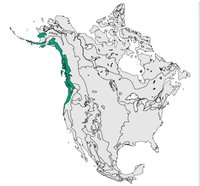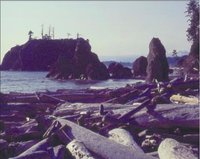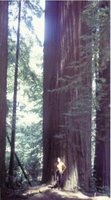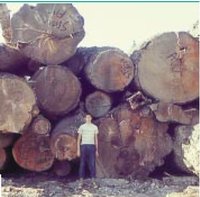Marine West Coast Forests ecoregion (CEC)
The Marine West Coast Forests ecoregion covers the mainland and offshore islands of the Pacific Coast from Alaska south to northern California. The wettest climates of North America occur in this area. It is characterized by mountainous topography bordered by coastal plains, and contains all of the temperate rain forests found in North America. These forests are among the most productive in North America, making forestry the major resource activity. Major commercial fisheries occur offshore. The large population of 6.5 million is concentrated in coastal cities and towns.
Physical Setting
Mountainous topography dominates, cut through by numerous fjords and glacial valleys, and bordered by coastal plains along the ocean margin. Igneous and sedimentary rocks underlie most of the area. Colluvium and morainal deposits are the main surface materials. The soils are largely leached, nutrient-poor forest soils. The Queen Charlotte Islands and the part of Vancouver Island that escaped glaciation are unique because they now contain many endemic species: that is, ones that are peculiar to those habitats. Ice-free coastal waters are associated with the narrow continental shelf and slope. The region has some of the most productive rivers for salmon production and there are many important estuaries.
 Chinook and coho salmon spawn in coastal streams and rivers. (Photo: U.S. EPA)
Chinook and coho salmon spawn in coastal streams and rivers. (Photo: U.S. EPA) The nearness of the Pacific Ocean profoundly moderates the climate. This maritime influence is responsible for a high level of precipitation, long growing season and moderate temperatures. Mean annual temperatures range from 5°C in the north to 9°C in northern California. The mean summer temperature ranges from 10°C in the north to 16°C in the south, whereas mean winter temperatures range from –1°C to –3°C. The annual precipitation ranges from as little as 600 millimeters (mm) in the gulf and San Juan islands to over 5,000 mm along the north coast of British Columbia and Alaska. Overall, the windward slopes typically receive between 1500 to 3000 mm of precipitation per year.
Biological Setting
 Pasture and dairy farms characterize many of the coastal lowlands and river valleys. Photo: U.S. EPA
Pasture and dairy farms characterize many of the coastal lowlands and river valleys. Photo: U.S. EPA Variations in altitude create widely contrasting ecological zones within the region. They range from mild, humid coastal rain forest to cool boreal forests and alpine conditions at higher elevations. The temperate coastal forests are composed of mixtures of western red cedar, yellow cedar, western hemlock, Douglas fir, amabalis fir, Sitka spruce, California redwood and red alder. Many of these trees reach very large dimensions and live to great age, forming ancient or old growth. In the drier rain-shadow areas, Garry oak and Pacific madrone occur with Douglas fir. Sub-alpine forests are characterized by mountain hemlock and amabalis fir. Alpine tundra conditions are too severe for growth of most woody plants except in dwarf form. This zone is dominated by shrubs, herbs, mosses and lichens.
Characteristic mammals include the black-tailed deer, black and grizzly bear, elk, wolf, otter and raccoon. Bird species unique to this area include California and mountain quail and chest- nut-backed chickadee. Many seabirds are prevalent, including marbled murrelets, and several species of cormorants, gulls, mures, petrels and puffins. Other representative birds are northern pygmy-owls, Steller’s jays, and northwestern crows. Adjacent marine environments are typified by large numbers of whales (including the killer whale), sea lions, seals and dolphins. Salmon, steelhead and associated spawning streams are located throughout this area. Coastal up-welling and freshwater discharge from coastal rivers into ocean waters stimulate the occurrence of abundant marine life.
Human Activities
Currently, most land use is linked to forest harvesting. Forest productivity is high and the commercial forest industry is of major economic importance to both Canada and the United States. The lowlands of the Puget Sound, Willamette Valley, Fraser Valley and the southeastern tip of Vancouver Island possess the area’s main expanse of highly productive agricultural soils, as well as urban lands. Fishing, tourism and transportation are other major activities. The total population is about 6.5 million; Anchorage, Vancouver, Victoria, Seattle and Portland are the principal cities of the region.
| Disclaimer: This article contains information that was originally published by the Commission for Environmental Cooperation. Topic editors and authors for the Encyclopedia of Earth have edited its content and added new information. The use of information from the Commission for Environmental Cooperation should not be construed as support for or endorsement by that organization for any new information added by EoE personnel, or for any editing of the original content. |




